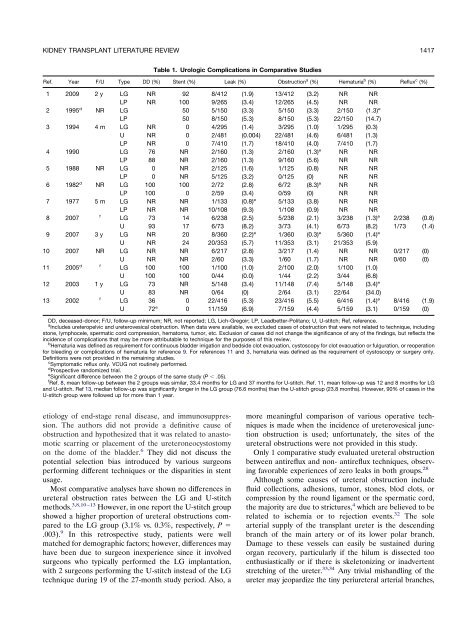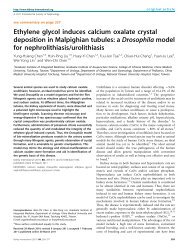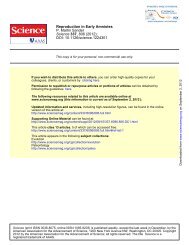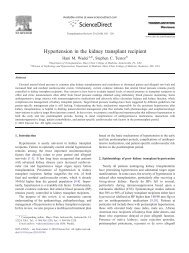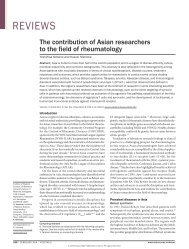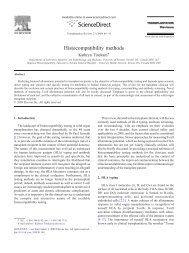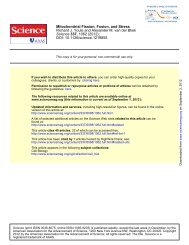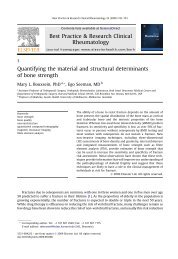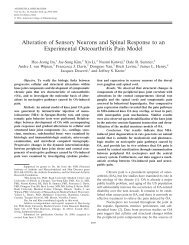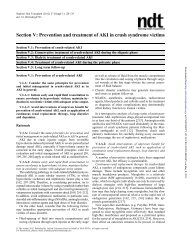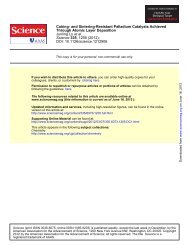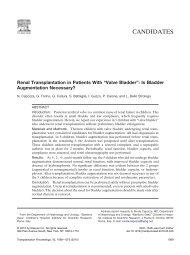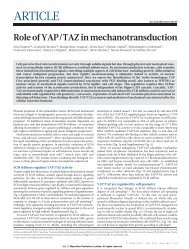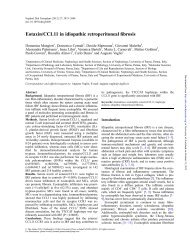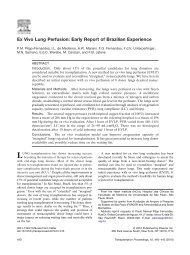Kidney Transplant Ureteroneocystostomy Techniques and ...
Kidney Transplant Ureteroneocystostomy Techniques and ...
Kidney Transplant Ureteroneocystostomy Techniques and ...
You also want an ePaper? Increase the reach of your titles
YUMPU automatically turns print PDFs into web optimized ePapers that Google loves.
KIDNEY TRANSPLANT LITERATURE REVIEW 1417<br />
etiology of end-stage renal disease, <strong>and</strong> immunosuppression.<br />
The authors did not provide a definitive cause of<br />
obstruction <strong>and</strong> hypothesized that it was related to anastomotic<br />
scarring or placement of the ureteroneocystostomy<br />
on the dome of the bladder. 6 They did not discuss the<br />
potential selection bias introduced by various surgeons<br />
performing different techniques or the disparities in stent<br />
usage.<br />
Most comparative analyses have shown no differences in<br />
ureteral obstruction rates between the LG <strong>and</strong> U-stitch<br />
methods. 3,8,10–13 However, in one report the U-stitch group<br />
showed a higher proportion of ureteral obstructions compared<br />
to the LG group (3.1% vs. 0.3%, respectively, P <br />
.003). 9 In this retrospective study, patients were well<br />
matched for demographic factors; however, differences may<br />
have been due to surgeon inexperience since it involved<br />
surgeons who typically performed the LG implantation,<br />
with 2 surgeons performing the U-stitch instead of the LG<br />
technique during 19 of the 27-month study period. Also, a<br />
Table 1. Urologic Complications in Comparative Studies<br />
Ref. Year F/U Type DD (%) Stent (%) Leak (%) Obstruction a (%) Hematuria b (%) Reflux c (%)<br />
1 2009 2 y LG NR 92 8/412 (1.9) 13/412 (3.2) NR NR<br />
LP NR 100 9/265 (3.4) 12/265 (4.5) NR NR<br />
2 1995 d NR LG 50 5/150 (3.3) 5/150 (3.3) 2/150 (1.3) e<br />
LP 50 8/150 (5.3) 8/150 (5.3) 22/150 (14.7)<br />
3 1994 4 m LG NR 0 4/295 (1.4) 3/295 (1.0) 1/295 (0.3)<br />
U NR 0 2/481 (0.004) 22/481 (4.6) 6/481 (1.3)<br />
LP NR 0 7/410 (1.7) 18/410 (4.0) 7/410 (1.7)<br />
4 1990 LG 76 NR 2/160 (1.3) 2/160 (1.3) e NR NR<br />
LP 88 NR 2/160 (1.3) 9/160 (5.6) NR NR<br />
5 1988 NR LG 0 NR 2/125 (1.6) 1/125 (0.8) NR NR<br />
LP 0 NR 5/125 (3.2) 0/125 (0) NR NR<br />
6 1982 d NR LG 100 100 2/72 (2.8) 6/72 (8.3) e NR NR<br />
LP 100 0 2/59 (3.4) 0/59 (0) NR NR<br />
7 1977 5 m LG NR NR 1/133 (0.8) e 5/133 (3.8) NR NR<br />
LP NR NR 10/108 (9.3) 1/108 (0.9) NR NR<br />
8 2007 f LG 73 14 6/238 (2.5) 5/238 (2.1) 3/238 (1.3) e 2/238 (0.8)<br />
U 93 17 6/73 (8.2) 3/73 (4.1) 6/73 (8.2) 1/73 (1.4)<br />
9 2007 3 y LG NR 20 8/360 (2.2) e 1/360 (0.3) e 5/360 (1.4) e<br />
U NR 24 20/353 (5.7) 11/353 (3.1) 21/353 (5.9)<br />
10 2007 NR LG NR NR 6/217 (2.8) 3/217 (1.4) NR NR 0/217 (0)<br />
U NR NR 2/60 (3.3) 1/60 (1.7) NR NR 0/60 (0)<br />
11 2005 d f LG 100 100 1/100 (1.0) 2/100 (2.0) 1/100 (1.0)<br />
U 100 100 0/44 (0.0) 1/44 (2.2) 3/44 (6.8)<br />
12 2003 1 y LG 73 NR 5/148 (3.4) 11/148 (7.4) 5/148 (3.4) e<br />
U 83 NR 0/64 (0) 2/64 (3.1) 22/64 (34.0)<br />
13 2002 f LG 36 0 22/416 (5.3) 23/416 (5.5) 6/416 (1.4) e 8/416 (1.9)<br />
U 72 e 0 11/159 (6.9) 7/159 (4.4) 5/159 (3.1) 0/159 (0)<br />
DD, deceased-donor; F/U, follow-up minimum; NR, not reported; LG, Lich-Gregoir; LP, Leadbetter-Politano; U, U-stitch; Ref, reference.<br />
a<br />
Includes ureteropelvic <strong>and</strong> ureterovesical obstruction. When data were available, we excluded cases of obstruction that were not related to technique, including<br />
stone, lymphocele, spermatic cord compression, hematoma, tumor, etc. Exclusion of cases did not change the significance of any of the findings, but reflects the<br />
incidence of complications that may be more attributable to technique for the purposes of this review.<br />
b<br />
Hematuria was defined as requirement for continuous bladder irrigation <strong>and</strong> bedside clot evacuation, cystoscopy for clot evacuation or fulguration, or reoperation<br />
for bleeding or complications of hematuria for reference 9. For references 11 <strong>and</strong> 3, hematuria was defined as the requirement of cystoscopy or surgery only.<br />
Definitions were not provided in the remaining studies.<br />
c<br />
Symptomatic reflux only. VCUG not routinely performed.<br />
d<br />
Prospective r<strong>and</strong>omized trial.<br />
e<br />
Significant difference between the 2 groups of the same study (P .05).<br />
f<br />
Ref. 8, mean follow-up between the 2 groups was similar, 33.4 months for LG <strong>and</strong> 37 months for U-stitch. Ref. 11, mean follow-up was 12 <strong>and</strong> 8 months for LG<br />
<strong>and</strong> U-stitch. Ref 13, median follow-up was significantly longer in the LG group (76.6 months) than the U-stitch group (23.8 months). However, 90% of cases in the<br />
U-stitch group were followed up for more than 1 year.<br />
more meaningful comparison of various operative techniques<br />
is made when the incidence of ureterovesical junction<br />
obstruction is used; unfortunately, the sites of the<br />
ureteral obstructions were not provided in this study.<br />
Only 1 comparative study evaluated ureteral obstruction<br />
between antireflux <strong>and</strong> non- antireflux techniques, observing<br />
favorable experiences of zero leaks in both groups. 28<br />
Although some causes of ureteral obstruction include<br />
fluid collections, adhesions, tumor, stones, blod clots, or<br />
compression by the round ligament or the spermatic cord,<br />
the majority are due to strictures, 4 which are believed to be<br />
related to ischemia or to rejection events. 32 The sole<br />
arterial supply of the transplant ureter is the descending<br />
branch of the main artery or of its lower polar branch.<br />
Damage to these vessels can easily be sustained during<br />
organ recovery, particularly if the hilum is dissected too<br />
enthusiastically or if there is skeletonizing or inadvertent<br />
stretching of the ureter. 33,34 Any trivial mish<strong>and</strong>ling of the<br />
ureter may jeopardize the tiny periureteral arterial branches,


